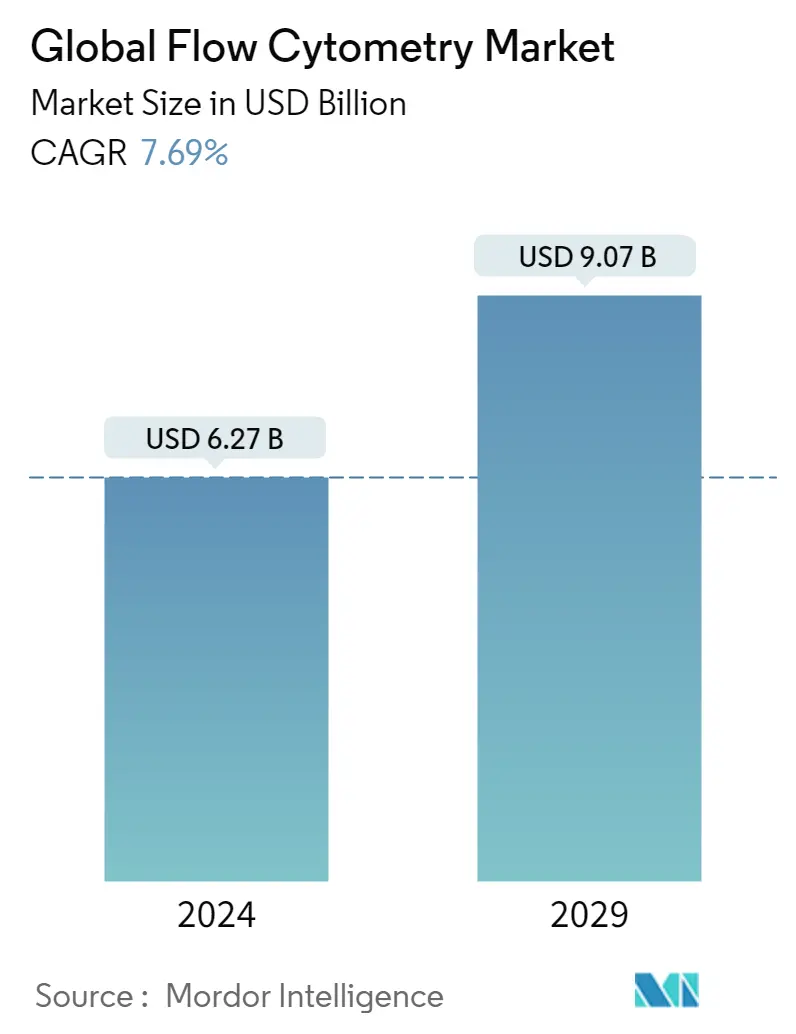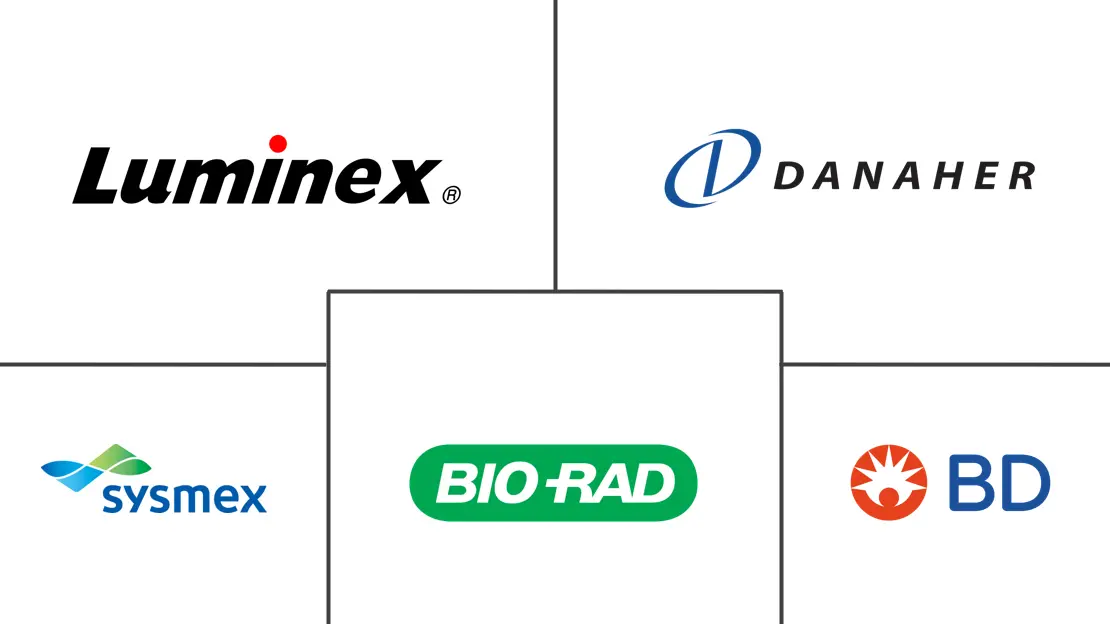Market Size of Global Flow Cytometry Industry

| Study Period | 2019 - 2029 |
| Market Size (2024) | USD 6.27 Billion |
| Market Size (2029) | USD 9.07 Billion |
| CAGR (2024 - 2029) | 7.69 % |
| Fastest Growing Market | Asia-Pacific |
| Largest Market | North America |
Major Players
*Disclaimer: Major Players sorted in no particular order |
Flow Cytometry Market Analysis
The Global Flow Cytometry Market size is estimated at USD 6.27 billion in 2024, and is expected to reach USD 9.07 billion by 2029, growing at a CAGR of 7.69% during the forecast period (2024-2029).
The COVID-19 pandemic impacted the growth of the flow cytometry market. For instance, an article published in the journal Frontiers in Immunology in January 2022 reported that a flow cytometry-based high-throughput screening system is proposed for testing COVID-19 cases where the virus particle binds to specific primary antibodies and the resultant virus-antibody complex then binds to fluorescently tagged secondary antibodies. The fluorescence signal could be measured in a flow channel for the qualitative detection of the virus in the test sample. Thus, flow cytometry was used in the diagnosis of COVID-19 samples, and its use significantly increased during the pandemic. In the current scenario, with the decrease in COVID-19 cases, the demand for flow cytometry may stabilize compared to the beginning of the pandemic. However, according to research in the pharmaceutical and healthcare industries, the demand for flow cytometry is expected to witness significant growth over the forecast period.
The factors that are driving the growth of the studied market are the growing adoption of flow cytometry in stem cell research and the increasing applications of flow cytometry in clinical research. In April 2022, for example, the International Journal of Laboratory Haematology published an article saying that flow cytometry is a method used in many different situations to look at the characteristics of a mixed cell population from peripheral blood (PB), bone marrow (BM), and solid tissues that can be broken up into single cells for further study.Thus, such use of flow cytometry is driving the growth of the studied market.
Additionally, FlowMetric Company reported in a May 2022 article that flow cytometry techniques have been a useful tool for drug development with the advantage of enabling multiplexed phenotypic primary screening of cells and screening of sources for biological drugs like antibodies.The article also said that flow cytometry is very important in almost every step of developing CAR-T therapy.This includes figuring out what's wrong with the patient, figuring out what the product is made of and how pure it is, and figuring out what's going on after the infusion (like the patient's functional state and the loss of the target antigen).Flow cytometry is used a lot in the process of making new drugs. This helps the studied market grow.
Also, the high number of cases of Leishmania is increasing the demand for flow cytometry. For example, an article published in the journal Biochemistry Research International in April 2022 stated that visceral leishmaniasis (VL), also known as kala-azar, affects approximately 50,000-90,000 people worldwide each year. Thus, such a high number of VL cases is fueling the growth of the studied market.
Furthermore, new product launches by key market players are propelling the studied market's growth. For instance, in August 2021, Becton, Dickinson, and Company launched a new benchtop cell analyzer, the BD FACSymphony A1 Cell Analyzer. The fluorescence-activated cell analyzer is expected to equip laboratories of all sizes with sophisticated flow cytometry capabilities.
So, the studied market is expected to grow a lot over the next few years because stem cell research is using flow cytometry more and more, flow cytometry is being used more and more in clinical research, there are a lot of leishmaniasis cases, and new products are coming out. However, due to the lack of awareness about the potential benefits of flow cytometry techniques and the high cost of the equipment, the growth of the studied market may be hindered during the forecast period.
Flow Cytometry Industry Segmentation
Flow cytometry is a laser- or impedance-based technology that is used to count cells, find biomarkers, sort cells, and build proteins, according to the scope of this report. It's done by putting the cell in a stream of fluid and then moving it through a machine that can find it. It is the best way to find, describe, and separate stem cells and progenitor cells for research and possible use in the clinic. The flow cytometry market is classified as follows: Product Type (Instrument, Kits & Reagents, and Software & Services), Technology (Cell-Based Flow Cytometry and Bead-Based Flow Cytometry), Application (Oncology, Drug Discovery, Stem Cell Therapy & Organ Transplantation, Hematology, and Other Applications), End User (Hospitals and Clinics, Academia and Research Institutes, Pharmaceutical and Biotechnology Companies, and Other The report offers the value (in USD million) for the above segments. The market report also covers the estimated market sizes and trends for 17 countries across major regions globally. The report offers the value (in USD million) for the above segments.
| By Product Type | |
| Instrument | |
| Kit and Reagent | |
| Software and Services |
| By Technology | |
| Cell-based Flow Cytometry | |
| Bead-based Flow Cytometry |
| By Application | |
| Oncology | |
| Drug Discovery | |
| Stem Cell Therapy | |
| Organ Transplantation | |
| Hematology | |
| Other Applications |
| By End-User | |
| Hospitals and Clinics | |
| Academia and Research Institutes | |
| Pharmaceutical and Biotechnology Companies | |
| Other End-Users |
| Geography | ||||||||
| ||||||||
| ||||||||
| ||||||||
| ||||||||
|
Global Flow Cytometry Market Size Summary
The flow cytometry market is poised for substantial growth over the forecast period, driven by its increasing adoption in various research and clinical applications. The technology's role in stem cell research and clinical diagnostics has been pivotal, with its ability to analyze and sort cells at a granular level enhancing research outcomes and therapeutic developments. The market's expansion is further supported by the rising incidence of diseases such as leishmaniasis and HIV, which necessitate advanced diagnostic tools like flow cytometry. Additionally, the introduction of innovative products by key market players is expected to bolster market growth, providing researchers and clinicians with sophisticated tools to enhance their workflows and outcomes.
Despite the promising growth trajectory, the flow cytometry market faces challenges, including high equipment costs and limited awareness of its benefits among potential users. However, the ongoing advancements in tandem flow cytometry technologies and the increasing number of clinical trials, particularly in stem cell therapy, are anticipated to drive demand. The competitive landscape remains robust, with major players like Becton, Dickinson and Company, Danaher Corporation, and others maintaining significant market shares. These companies continue to innovate, as evidenced by recent product launches and cloud-based solutions that streamline data analysis and improve research efficiency. As a result, the market is expected to experience significant growth, particularly in regions like North America, where research activities and disease prevalence are high.
Global Flow Cytometry Market Size - Table of Contents
-
1. MARKET DYNAMICS
-
1.1 Market Overview
-
1.2 Market Drivers
-
1.2.1 Growing Adoption of Flow Cytometry in Stem Cell Research
-
1.2.2 Increasing Applications of Flow Cytometry in Clinical Research
-
-
1.3 Market Restraints
-
1.3.1 Lack of Awareness about the Potential Benefits of Flow Cytometry Techniques
-
1.3.2 High Cost of the Equipment
-
-
1.4 Industry Attractiveness - Porter's Five Forces Analysis
-
1.4.1 Threat of New Entrants
-
1.4.2 Bargaining Power of Buyers/Consumers
-
1.4.3 Bargaining Power of Suppliers
-
1.4.4 Threat of Substitute Products
-
1.4.5 Intensity of Competitive Rivalry
-
-
-
2. MARKET SEGMENTATION (Market Size by Value - USD million)
-
2.1 By Product Type
-
2.1.1 Instrument
-
2.1.2 Kit and Reagent
-
2.1.3 Software and Services
-
-
2.2 By Technology
-
2.2.1 Cell-based Flow Cytometry
-
2.2.2 Bead-based Flow Cytometry
-
-
2.3 By Application
-
2.3.1 Oncology
-
2.3.2 Drug Discovery
-
2.3.3 Stem Cell Therapy
-
2.3.4 Organ Transplantation
-
2.3.5 Hematology
-
2.3.6 Other Applications
-
-
2.4 By End-User
-
2.4.1 Hospitals and Clinics
-
2.4.2 Academia and Research Institutes
-
2.4.3 Pharmaceutical and Biotechnology Companies
-
2.4.4 Other End-Users
-
-
2.5 Geography
-
2.5.1 North America
-
2.5.1.1 United States
-
2.5.1.2 Canada
-
2.5.1.3 Mexico
-
-
2.5.2 Europe
-
2.5.2.1 Germany
-
2.5.2.2 United Kingdom
-
2.5.2.3 France
-
2.5.2.4 Italy
-
2.5.2.5 Spain
-
2.5.2.6 Rest of Europe
-
-
2.5.3 Asia-Pacific
-
2.5.3.1 China
-
2.5.3.2 Japan
-
2.5.3.3 India
-
2.5.3.4 Australia
-
2.5.3.5 South Korea
-
2.5.3.6 Rest of Asia-Pacific
-
-
2.5.4 Middle East and Africa
-
2.5.4.1 GCC
-
2.5.4.2 South Africa
-
2.5.4.3 Rest of Middle East and Africa
-
-
2.5.5 South America
-
2.5.5.1 Brazil
-
2.5.5.2 Argentina
-
2.5.5.3 Rest of South America
-
-
-
Global Flow Cytometry Market Size FAQs
How big is the Global Flow Cytometry Market?
The Global Flow Cytometry Market size is expected to reach USD 6.27 billion in 2024 and grow at a CAGR of 7.69% to reach USD 9.07 billion by 2029.
What is the current Global Flow Cytometry Market size?
In 2024, the Global Flow Cytometry Market size is expected to reach USD 6.27 billion.

